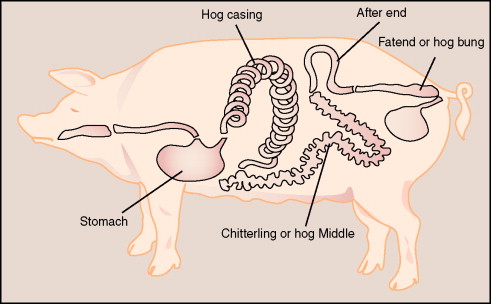To make a good sausage or salami, the type of natural casing and its calibre (diameter) varies relatively depending on the region and country.
However, there are a number of general applications and habits that stand out, particularly in our beautiful French countryside and cities.
We present you an overview of these below:
SHEEP CASINGS
In the small intestine called "sheep casing"
- Sheep casings, tender and delicate casings, are generally used for making small sausages such as chipolatas, merguez, fresh sausages (nature sausages, Indian sausages, vigneronne sausages, burger sausages, etc.), cocktail sausages.
- The choice of calibre is up to you depending on the desired wideness, but generally 20/22 and 22/24 are well suited for merguez, while other sausages will prefer 22/24 or 24/26 (Beware of the diameter of your nozzle).
- 26/28 will be more used in wide fresh sausages such as enrolled sausages, or knacks, Frankfurt sausages, sauerkraut sausages.
- 18/20 will be mainly reserved for small merguez, cocktail sausages or other regional or Asian specialities.
- The large intestine is not used in charcuterie but is still used to produce condoms ( yes, yes, this is true ! )
HOG CASINGS
In the small intestine called "Hog casing"
- With a thicker structure than sheep casings, hog casings are used for larger sausages such as Toulouse sausage, white pudding, black pudding (30/32 to 34/36 depending on the region), narrow hog casings (26/28 and 28/30) will be more popular in the East of France for white sausage, roasting sausage (bratwurst), gendarme etc...
- You can also make small dry sausage or chorizo in 34/36 or 36/40.
Sow casings
- Sow casings are stronger than hog casings and are often used to make dry sausage (perche sausage with large round trips).
- Depending on the desired final diameter, you will use calibres 38/40 to 45/+, the drying time will be proportional.
In the large intestine
- The large intestine is called "Chitterling" and is often used to make dry sausage (hence the convolutions of the casing) but also more particularly to make country pudding (meat pudding), Landes pudding.
- The chitterling is also the main constituent ("the meat") with the stomach, of andouillette and andouille.
- The afterend (smooth part between the fatend and the chitterling) is mainly used for andouillette and morteau sausage.
- Some people use it to make dry sausage but, in our opinion, it is not the most suitable casing.
- The fatend (the final part of the large intestine) is used in the manufacture of the rosette de Lyon, the fuseau lorrain or the liver sausage.
- the hog bung (appendix of the pig), are mainly used in the manufacture of mountain sausage (Jésus), coppa, mouchettes or bardin bags (specialty of the Forez region).
BEEF CASINGS
In the small intestine called "beef round" ( curved form casing)
- The narrow calibres 34/37 and 37/40 are used for the manufacture of black pudding, Creole pudding and certain andouillettes (in Cambrai in particular).
- Some regions also use these calibres to make pure beef dry sausages.
- 40/43 and 43/46, intermediate calibres, will be used more for cooked sausages such as garlic sausage, horse sausage, Paris Ail,
- 46/+ will be used for the same applications, but the sausage will, of course, be larger.
In the large intestine called "beef middle" (straight form casing)
- The beef middle is distinguished from the beef round by its straight and cylindrical shape, its tissue is among the strongest of the casings, especially in 1st choice (Quality IA) as proposed by CEBONAT®.
- We recommend its use in the manufacture of dry sausage because it is a more stable casing over time than the chitterling which is likely to rancid and is stronger than the latter.
- The choice of calibre (from 50/55 to 60/+) is up to you depending on the wideness of the final product you want.
- The 50/55 or 55/60 is mainly used.
- The beef middle is also used in all the manufacture of straight cooked sausages (garlic sausages, Lyon sausages, cervelas etc...)
-
Finally, the beef bung (appendix of the beef, called also " cap" when cut) will be mainly used to make coppa, andouillette or Danish salami
HORSE CASINGS
- Only the small intestine of the horse is used in charcuterie.
- The tissue of the horse casing is even more resistant and thicker than that of beef casings.
- Its calibres 50/55 - 55/60 - 60/65 -65/70-70/75 -75/+ or 80/+ are mainly used in the manufacture of andouilles.
- It's up to you to choose the size!
-
That's it, we've told you everything! Don't hesitate to add to the list of products made with casings in your regions by contacting us directly.








